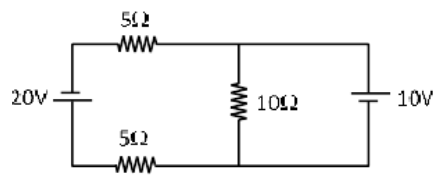A galvanic cell has an electrical potential of 1.1V. If an opposing potential of 1.1 V is applied to this cell, what will happen to the cell reaction and current flowing through the cell?
To solve the problem, we will analyze the effects of applying an opposing potential to a galvanic cell with a given electrical potential.
1. Identify the Given Values:
- The galvanic cell has an electrical potential (EMF) of 1.1 V.
- An opposing potential of 1.1 V is applied to the cell.
2. Understand the Concept of Opposing Potential:
- The opposing potential is the external voltage applied in the opposite direction to the cell's natural voltage. This can be thought of as an external electromotive force (EMF).
3. Compare the Cell Potential and Opposing Potential:
- Since the opposing potential (1.1 V) is equal to the cell potential (1.1 V), we can conclude that the two potentials are balanced.
4. Determine the Effect on the Cell Reaction:
- When the opposing potential is equal to the cell potential, the electrochemical reaction in the galvanic cell will stop. This is because the energy provided by the external potential is sufficient to counteract the energy produced by the cell.
5. Determine the Effect on Current Flow:
- Since the reaction stops, there will be no current flowing through the cell. The flow of current is directly related to the occurrence of the electrochemical reaction; if the reaction ceases, so does the current.
Conclusion:
When an opposing potential of 1.1 V is applied to a galvanic cell with the same potential, the cell reaction stops, and no current flows through the cell.
---
- The galvanic cell has an electrical potential (EMF) of 1.1 V.
- An opposing potential of 1.1 V is applied to the cell.
- The opposing potential is the external voltage applied in the opposite direction to the cell's natural voltage. This can be thought of as an external electromotive force (EMF).
- Since the opposing potential (1.1 V) is equal to the cell potential (1.1 V), we can conclude that the two potentials are balanced.
- When the opposing potential is equal to the cell potential, the electrochemical reaction in the galvanic cell will stop. This is because the energy provided by the external potential is sufficient to counteract the energy produced by the cell.
- Since the reaction stops, there will be no current flowing through the cell. The flow of current is directly related to the occurrence of the electrochemical reaction; if the reaction ceases, so does the current.
When an opposing potential of 1.1 V is applied to a galvanic cell with the same potential, the cell reaction stops, and no current flows through the cell.
Topper's Solved these Questions
- D AND F-BLOCK ELEMENTSBOOK - NCERT EXEMPLAR ENGLISHCHAPTER - D AND F-BLOCK ELEMENTSEXERCISE - Short Answer Type Question
20 Videos
- GENERAL PRINCIPLE AND PROCESSES OF ISOLATION OF ELEMENTS BOOK - NCERT EXEMPLAR ENGLISHCHAPTER - GENERAL PRINCIPLE AND PROCESSES OF ISOLATION OF ELEMENTS EXERCISE - Long Answer Type Questions
1 Videos
Similar Questions
Knowledge Check
A galvanic cell has electrical potential of 1.1 V . If an opposing potential of 1.1 V is applied to this cell, what will happen to the cell reaction and current flowing through the cell ?
AThe reaction stops and no current flows through the cell.BThe reaction continuous but current flows in opposite direction.CThe concentration of reactants becomes unity and current flows from cathode to anode.DThe cell does not function as a galvanic cell and zinc is deposited on zinc plate.In the circuit shown in figure the current flowing through 25 V cell is
 A7.2AB10AC12AD14.2A
A7.2AB10AC12AD14.2AIn the circuit shown in figure the current flowing through 25 V cell is
 A7.2AB10AC12AD14.2A
A7.2AB10AC12AD14.2A
Find current in 10V cell

View SolutionIn a galvanic cell, the half cell with higher potential provides a reducing agent.
View SolutionThe cell reaction as written is spontaneous if the cell potential is:
View SolutionA plant cell is kept in a hypotonic solution. What will happen to the solute potential of this cell?
View SolutionWhat is an electrochemical cell or galvanic cell?
View Solution

